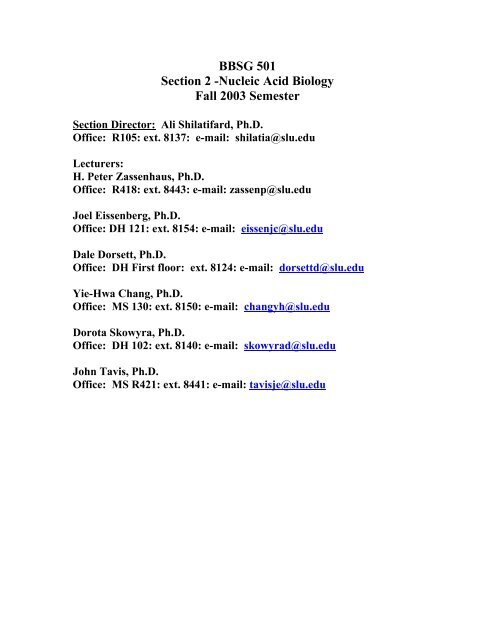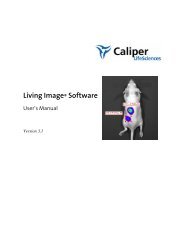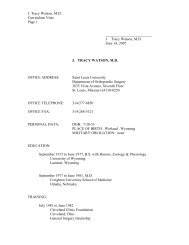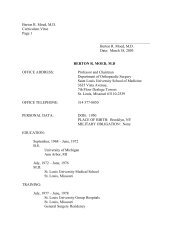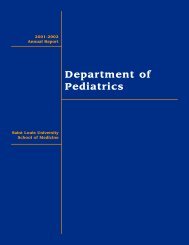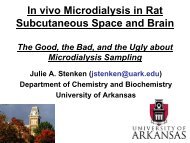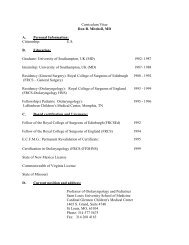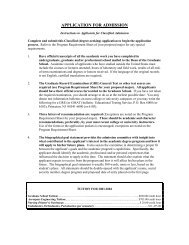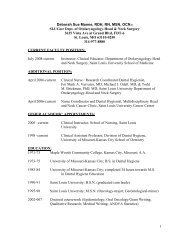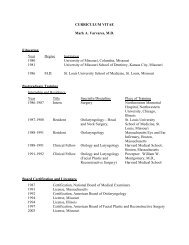Nucleic Acid Biology
Nucleic Acid Biology
Nucleic Acid Biology
You also want an ePaper? Increase the reach of your titles
YUMPU automatically turns print PDFs into web optimized ePapers that Google loves.
BBSG 501<br />
Section 2 -<strong>Nucleic</strong> <strong>Acid</strong> <strong>Biology</strong><br />
Fall 2003 Semester<br />
Section Director: Ali Shilatifard, Ph.D.<br />
Office: R105: ext. 8137: e-mail: shilatia@slu.edu<br />
Lecturers:<br />
H. Peter Zassenhaus, Ph.D.<br />
Office: R418: ext. 8443: e-mail: zassenp@slu.edu<br />
Joel Eissenberg, Ph.D.<br />
Office: DH 121: ext. 8154: e-mail: eissenjc@slu.edu<br />
Dale Dorsett, Ph.D.<br />
Office: DH First floor: ext. 8124: e-mail: dorsettd@slu.edu<br />
Yie-Hwa Chang, Ph.D.<br />
Office: MS 130: ext. 8150: e-mail: changyh@slu.edu<br />
Dorota Skowyra, Ph.D.<br />
Office: DH 102: ext. 8140: e-mail: skowyrad@slu.edu<br />
John Tavis, Ph.D.<br />
Office: MS R421: ext. 8441: e-mail: tavisje@slu.edu
DATES: 9/15/03 – 9/16/03 Lecturer: Ali Shilati , Ph.D.<br />
Reading: Maniatis, Chapter 14 (will be handed out in class), Molecular <strong>Biology</strong> of the<br />
Cell Chapter 7. P 291-334.<br />
Lecture 1: Overview of Molecular Techniques/Structure of the<br />
Eukaryotic Nucleus<br />
Monumental Steps in the Development of Recombinant DNA technology<br />
1-Isolation of DNA<br />
2-Discovary of DNA polymerase<br />
3-Discovary of DNA re-naturation<br />
4-Discovery and usage of restriction nucleases<br />
5-Elucidation of genetic code<br />
6-Discovary of reverse transcriptase<br />
7-Cloning of cDNA<br />
8-Discovery of DNA hybridization methods<br />
9-DNA sequencing<br />
10-Polymerase Chain Reaction (PCR)<br />
11-EST libraries<br />
12-DNA sequencing using CE<br />
13-Development of MALDI methods for protein identification<br />
14-Sequencing the genome human and other organisms<br />
15-Your future contributions<br />
DNA polymerases and their usage in molecular biology<br />
A. I. Mammalian DNA polymerase<br />
a) The discovery<br />
b) The Mechanism of action<br />
B. II. Taq DNA polymerase<br />
a) Advantage of its use<br />
b) Disadvantages of its use<br />
C. III. Taq DNA polymerase with proof reading ability<br />
Use of Taq DNA polymerase in PCR<br />
a)Subcloning of cDNA and DNAs<br />
b)DNA sequencing via Taq and PCR<br />
c)Cloning the end of genes<br />
d)Generation of mutation and deletion with DNA polymerase
Lecture 2: Structure of the Eukaryotic Nucleus<br />
Intracellular Compartments and Protein Sorting<br />
A. The Compartmentalization of Higher Cells<br />
I. Intracellular compartments<br />
II. Relative amounts of membrane<br />
B. The Protein Movements Between Compartments<br />
I. Vesicular transport<br />
II Transmembrane transport<br />
III Gated transport<br />
C. Typical Signal Peptides<br />
D. Experimental Approaches for Defining Signal Sequences<br />
I. Protein fusion method<br />
II. Signal exchange method<br />
E. The Nucleus<br />
I. Nuclear structure<br />
II. The nuclear pore complex<br />
F. Transport to Nucleus<br />
I. Nuclear localization signal (NLS)<br />
II. Diffusion through the nuclear pore<br />
III. Nuclear import through glucocorticoid receptor<br />
IV. Reaction mechanism<br />
V. Type of polymerases (I, II, and III)<br />
VI. Discovery of RNA polymerases
DATE: 9/17/03 Lecturer: Ali Shilatifard, Ph.D.<br />
Lecture 3: <strong>Nucleic</strong> <strong>Acid</strong> <strong>Biology</strong><br />
Reading: Molecular <strong>Biology</strong> of the Cell pp. 421-434<br />
Cellular RNA is Synthesized by RNA Polymerases<br />
VII. Reaction mechanism<br />
VIII. Type of polymerases (I, II, and III)<br />
IX. Discovery of RNA polymerases<br />
Basal Transcription Machinery and Their Purification<br />
I. The promoter element and the TATA box<br />
II. Basal transcription factors<br />
III. Preinitiation complex formation<br />
IV. Promoter clearance<br />
V. Transcription elongation<br />
VI. Transcription termination<br />
Transcriptional Activation<br />
Transcriptional Enhancers and Regulation of Gene Expression<br />
I. The gene control region of typical eukaryotic gene<br />
II. The modular structure of a gene activator protein<br />
Transcriptional Repression<br />
I. Competitive DNA binding<br />
II. Masking the activation surface<br />
III. Direct interaction with basal transcription machinery<br />
DATE: 9/18/03 Lecturer: Ali Shilati, Ph.D.<br />
Lecture 4: <strong>Nucleic</strong> <strong>Acid</strong> <strong>Biology</strong><br />
Reading: Review by Shilatifard<br />
Regulation of Transcription Elongation<br />
Transcription Initiation and Promoter Clearance<br />
Factors involved in the initiation of transcription<br />
Factors involved in the promoter clearance
DATE: 9/18/03 Lecturer: Ali Shilati, Ph.D.<br />
Lecture 4: <strong>Nucleic</strong> <strong>Acid</strong> <strong>Biology</strong> (continued)<br />
RNA polymerase II General Elongation Factors<br />
Classes of elongation factors<br />
Assays of transcription elongation<br />
Purification of the Pol II elongation factors<br />
RNA Polymerase II Elongation and Human Cancer<br />
Elongation and VHL<br />
ELL and Leukemia<br />
DATES: 9/19/03 & 9/22/03 Lecturer: H. P. Zassenhaus, Ph.D.<br />
Lecturers 5 & 6 <strong>Nucleic</strong> <strong>Acid</strong> <strong>Biology</strong><br />
Required readings from your textbook are: Molecular <strong>Biology</strong> of the Cell, 3rd edition;<br />
Mechanism of Transcription: pp 223-227 and pp 365-371<br />
Regulation of Transcription pp 401-408; 417-420; 443-444<br />
Post-transcriptional regulation: pp 453-468<br />
Please read your text before coming to class.<br />
Lectures on Bacterial Gene Regulation and the Mechanisms of mRNA<br />
Stability in Eukaryotes<br />
We will also discuss issues presented in two review articles which will be handed out<br />
ahead of class. These should be read after Lecture 1 but before Lecture 2!<br />
1) The Functional and Regulatory Roles of Sigma Factors in Transcription, Gross et al.,<br />
Cold Spring Harbor Symp on Quant <strong>Biology</strong>, Vol. 63, 141-155 (1998)<br />
2) mRNA Stability in Eukaryotes, Mitchell and Tollervey, Current Opinions in Genetics<br />
and Development, Vol. 10, 193-198 (2000)<br />
Lecture 1: Regulation of transcription in bacteria<br />
A) The importance of low affinity binding for gene regulation<br />
1. Multiple weak binding increases affinity in a synergistic manner<br />
2. Allows for combinatorial control<br />
3. Makes changes in binding affinity by protein modification more effective<br />
4. Permits faster response times by increasing the rate of dissociation
Lecture 1: Regulation of transcription in bacteria (continued)<br />
B) Structure of the E. coli RNA polymerase (Text pp 365-367)<br />
1. Composed of 3 different subunits<br />
2. Promoter specificity and binding determined by sigma class of<br />
transcription factors (Text pp 430-432)<br />
3. Promoter sequence defined by –10 and –35 elements which interact<br />
with RNA polymerase in a topologically constrained mechanism (Text pp 226)<br />
C) Mechanism of transcriptional initiation (Text pp 223-227)<br />
1. Binding of RNA polymerase to promoter in a closed complex<br />
2. Isomerization of bound polymerase to open complex<br />
3. Release of sigma factor<br />
4.. Role of pausing during elongation<br />
D) Regulation of transcription (Text pp 417-420)<br />
1. Promoter sequence affects both binding and isomerization<br />
2. Transcription factors in bacteria are called repressors and activators<br />
3. Regulation by occlusion of promoter sequence (Text pp418 and 420)<br />
4. Transcription factors regulate binding affinity and kinetics of<br />
isomerization<br />
Lecture 2: The regulation of mRNA Stability in Eukaryotes<br />
A) How important is mRNA stability for the regulation of gene expression<br />
1) A mathematical model for mRNA decay<br />
2) The time it takes for a cell to change the concentration of a mRNA from one<br />
steady-state level to another only depends upon the rate of mRNA decay – it does<br />
not depend on the rate of transcription!!!<br />
B) Structural elements of eukaryotic mRNAs important for stability<br />
1) The 5’ cap<br />
2) The 3’ poly(A) tail<br />
3) Stability determinants<br />
C) Mechanism of mRNA decay<br />
1) Processive exonucleolytic degradation<br />
2) Which end goes first?<br />
3) Regulation of mRNA turnover
DATES: 9/23/03, 9/24/03, 9/25/03 Lecturer: Joel Eissenberg, Ph.D.<br />
Lecturers 7, 8, 9: <strong>Nucleic</strong> <strong>Acid</strong> <strong>Biology</strong><br />
In each lecture, I'll present some background material related to the key question of the<br />
topic, then cover in some detail a research paper illustrating an experimental approach to<br />
answering this question.<br />
1. Chromatin structure and transcription I<br />
Key question: How does a transcription factor interact with a nucleosomal template?<br />
Owen-Hughes, T., and J.L. Workman (1996) Remodeling the chromatin structure of a<br />
nucleosome array by transcription factor-targeted trans-displacement of histones. EMBO<br />
J. 15: 4702-4712<br />
2. Chromatin structure and transcription II<br />
Key question: How is chromatin modified to facilitate gene activation?<br />
Kuo, M.-H., J. Zhou, P. Jambeck, M. E.A. Churchill, and C. D. Allis (1998) Histone<br />
acetyltransferase activity of yeast Gcn5p is required for the activation of target genes in<br />
vivo. Genes Devel. 12: 627-639<br />
3. Chromatin structure and repression<br />
Key question: How does a chromatin repressor silence genes?<br />
Nielsen, S.J., R. Schneider, U.-M. Bauer, A.J. Bannister, A. Morrison, D. O’Carroll, R.<br />
Firestein, M. Cleary, T. Jenuwein, R.E. Herrera, and T. Kouzarides (2001) Rb targets<br />
histone H3 methylation and HP1 to promoters. Nature 412:561-565
DATES: 9/26, 2003, 9/29/03, 9/30/03 Lecturer: Dale Dorsett, Ph.D.<br />
Lecturer 10: <strong>Nucleic</strong> <strong>Acid</strong> <strong>Biology</strong><br />
Recommended Text: Ptashne M, Gann A. Genes and Signals<br />
Transcriptional Activation in Yeast: The Gal4 Paradigm<br />
The Gal4 activator<br />
Separate DNA-binding and activation domains<br />
Activation domain structure<br />
Squelching<br />
Recruitment<br />
Activator bypass<br />
Nucleosomes and chromatin modifiers<br />
Gal4 targets<br />
Repression of Gal4 activation by Mig-1 and Tup<br />
DNA looping and local concentration<br />
Reading Assignment:<br />
For both lectures of October 15 and 16, Chapters 1, 2 and 3 of Ptashne & Gann<br />
Lecture 11: Activation in Higher Eukaryotes<br />
Targets of recruitment<br />
Recruitment at the Drosophila hsp70 gene<br />
Combinatorial control and alternative enhancers<br />
Remote enhancers<br />
Insulators<br />
DNA methylation and imprinting<br />
Chromosomal position effects<br />
Reading Assignment: see above<br />
Lecture 12: RNA Processing<br />
Production of Mature Messenger RNA and the mRNA Life Cycle<br />
mRNA capping<br />
mRNA splicing<br />
reiterative splicing of long introns<br />
mRNA polyadenylation<br />
The PolII CTD and coordination of transcription and processing<br />
mRNA transport<br />
mRNA degradation and turnover<br />
Degradation of missense mutant mRNA<br />
Mechanisms of RNAi-induced degradation
Reading Assignment:<br />
Bentley D. 1999. Coupling RNA polymerase II transcription with pre-mRNA<br />
processing. Curr Opin Cell Biol 11:347-51<br />
Hatton AR, Subramanian V, Lopez AJ. 1998. Generation of alternative<br />
Ultrabithorax isoforms and stepwise removal of a large intron by resplicing at<br />
exon-exon junctions. Mol Cell 2:787-96<br />
DATES: 10/1/2003, 10/2/2003 Lecturer: Yie-Hwa Chang, Ph.D.<br />
Lecturer 13: <strong>Nucleic</strong> <strong>Acid</strong> <strong>Biology</strong><br />
Protein synthesis I<br />
Suggested readings:<br />
Cell and Molecular <strong>Biology</strong>, Kleinsmith and Kish(2 nd edition), Chapter 11<br />
Berg JM, Lorsch JR (2001) Mechanism of ribosomal peptide bond formation. Science.<br />
291:203<br />
Ibba, M., Soll, D. (1999) Quality control mechanism during translation. Science.<br />
286:1893.<br />
1. Ribosome structure<br />
2. Protein synthesis<br />
3. mRNA<br />
4. tRNA<br />
5. The initiation of protein synthesis<br />
6. Peptide bond formation<br />
7. Translocation<br />
8. Termination of protein synthesis<br />
9. Polysomes<br />
OUTLINE
Suggested readings:<br />
Lecture 14 : Protein synthesis II<br />
Cell and Molecular <strong>Biology</strong>, Kleinsmith and Kish(2 nd edition), Chapter 11<br />
Pestova TV, et al. (2001) Molecular mechanism of translation initiation in eukaryotes.<br />
Proc. Natl. Acad. Sci. USA 98:7029.<br />
Gale, M., Tan, S.L., Katze, M.G. (2000) Translational control of viral gene expression in<br />
eukaryotes. Microbiol. Mol. Biol. Rev. 64:239.<br />
1. Translational repressors<br />
2. Life span of mRNA<br />
3. Antisense RNA<br />
4. Phosphorylation<br />
5. Availability of tRNA<br />
6. Rate of termination of transcription<br />
7. Initiation factors<br />
OUTLINE<br />
DATE: 10/3/2003 Lecturer: Dorota Skowyra, Ph.D.<br />
Lecture 15: <strong>Nucleic</strong> <strong>Acid</strong> <strong>Biology</strong><br />
Protein Folding and its Quality Control by Cellular Systems<br />
Summary: I will briefly describe main intracellular protein folding machineries (molecular<br />
chaperones, Hsp60, Hsp70) and introduce the issue of intracellular protein degradation,<br />
highlighting the function of both systems in cellular protein quality control.<br />
Introduction: once synthesized on the ribosome, every polypeptide needs to fold into a<br />
conformation that ensures its designed function, modification and/or interaction with<br />
other proteins. Frequently, such conformation involves multiple independently folded<br />
modules and is hard to be achieved by spontaneous folding of the polypeptide itself in the<br />
time frame that is available. In the cell, protein folding is assisted by molecular<br />
chaperones, which in multiple rounds of ATP-dependent binding, unfolding, and release<br />
‘massage’ the protein into its optimal shape. If this process fails, the misfolded or<br />
improperly assembled polypeptides are recognized by cellular quality control systems<br />
and eliminated by targeted proteolysis . A proteolytic pathway that recognizes and
destroys abnormal proteins must be able to distinguish between completed proteins that<br />
have ‘wrong’ conformations and the many growing polypeptides on ribosomes that have<br />
yet not achieved their normal folded conformation. That this is not a trivial issue is<br />
demonstrated by the observation that in normal growth conditions approximately one<br />
third of newly synthesized proteins are degraded within minutes of their synthesis.<br />
Problem (prepare your opinion to discuss in class): In your opinion, is the high rate of<br />
degradation of the newly synthesized proteins a likely evolutionary solution to the<br />
problem of optimizing the cost of a successful gene expression? What could be the<br />
possible evolutionary advantage of the cellular ‘waste’ problem?<br />
Recommended Reading:<br />
(1). Alberts, B. et al. (1994): The Birth, Assembly and Death of Proteins, in: Molecular<br />
<strong>Biology</strong> of the Cell, Chapter 5: Protein Function, pp. 212-222, Garland Publishing<br />
(2). Wickner, S., Maurizi, M.R., Gottesman, S. (1999): “Post-translational Quality<br />
Control: Folding, Refolding, and Degrading proteins.” Science 286, 1888-1893.<br />
Advanced Reading (not required but suggested):<br />
(3). Frydman, J. (2001): Folding of Newly Translated Proteins in vivo: The Role of<br />
Molecular Chaperones.” Annu.Rev.Biochem. 70, 603-47<br />
(4). Fewell, S.W., Travers, K.J., Weisman, J.S., Brodsky, J.L.: “ The Action of Molecular<br />
Chaperones in the Early Secretory Pathway.” Annu.Rev.Genet. 35, 149-91<br />
DATE: 10/6/03 Lecturer: Dorota Skowyra, Ph.D.<br />
Lecture 16: Ubiquitination and Proteolysis as key Regulatory Mechanisms<br />
of Gene Expression<br />
Summary: I will provide an overview of the currently known mechanisms responsible for<br />
substrate specificity in UPS (ubiquitin-proteasome system) and highlight their significance<br />
in the regulation of gene expression.<br />
Introduction: The current view is that the specificity and timing of intracellular proteolysis<br />
are controlled at a step of assembly of polyubiquitin chains on the substrate protein. In<br />
this view, the role of proteasomes is to recognize and degrade substrates that are selected<br />
for degradation by one of the specific ubiquitination systems.<br />
*Between the 1960s and 1980s protein degradation was a neglected area, considered to<br />
be a non-specific dead-end process. Although it was known that proteins do turn over, the<br />
large extend and high specificity of this process, whereby distinct proteins have half-lives<br />
that range from a few minutes to several days, was not appreciated. The discovery of the<br />
lysosome by Christian de Duve did not significantly change this view, because it became<br />
clear that this organelle is involved mostly in the degradation of extra-cellular proteins,<br />
and their proteases cannot be substrate specific. The discovery of the complex cascade of<br />
the ubiquitin pathway revolutionized the field. It is clear now that degradation of cellular<br />
proteins is a highly complex, temporary controlled, and tightly regulated process that
plays major roles in a variety of pathways during cell life and death, including the<br />
regulation of gene expression, stress and immune responses, cell cycle control and<br />
metabolic adaptation. Not surprisingly, defects in the ubiquitin-proteasome pathway have<br />
been implicated in the pathogenesis of a broad range of human diseases, including several<br />
forms of malignancies, a number of genetic diseases (cystic fibrosis, Angelman’s<br />
syndrome, Parkinson’s disease, Liddle syndrome), immunological disorders, and muscle<br />
wasting.<br />
Problem (prepare your opinion to discuss in class): how would you design an evolutionary<br />
conserved system for intracellular protein degradation which would be required to target<br />
80% of total cellular proteins in a specific, regulated (when needed), and timely (fast)<br />
manner?<br />
Recommended Reading:<br />
*(1). Selected chapters from: Glickman, M., and Ciechanover, A. (2002): “The<br />
Ubiquitin-Proteasome Proteolytic Pathway: Destruction for the Sake of Construction”,<br />
Physiol. Rev. 82: 373-428. Chapter I: Introduction and overview of ubiquitin-mediate<br />
proteolysis. pp. 374- 376 Chapter II: The ubiquitin conjugating machinery: E1, E2, E3.<br />
pp.377-381. Chapter IV: Modes of substrate recognition and regulation of the ubiquitin<br />
pathway. pp. 383-388<br />
DATE: 10/7/2003 Study Day<br />
DATE: 10/8/2003 EXAM<br />
9:00 – Noon LRC 105A, LRC 105B, LRC 106A<br />
DATE: 10/9/03 4:00 pm Lecture Rm A – Medical School<br />
Second William H. Elliott Lecture<br />
“Beyond the Double Helix: Writing and Reading<br />
the Histone Code”<br />
presented by C. David Allis, Ph.D.<br />
Joy and Jack Fishman Professor<br />
Head, Laboratory of Chromatin <strong>Biology</strong><br />
The Rockefeller University, New York, NY
DATE: 10/10/03 Lecturer: John Tavis, Ph.D.<br />
Lecture 18: <strong>Nucleic</strong> <strong>Acid</strong> <strong>Biology</strong><br />
Replication, Recombination and Repair<br />
Note: Copies of all required reading material will be on reserve in the library<br />
Oct. 10 (9:00) DNA Replication I<br />
Topics: Necessity of DNA replication, biological and biochemical constraints on DNA<br />
replication, overview of replication, initiation of DNA replication, enzymes of<br />
replication, the replication fork.<br />
Required reading: Alberts pp. 238-250, Stryer 799-809.<br />
Oct. 10 (10:00) DNA Replication II<br />
Topics: The replication fork in detail, termination and resolution, special problems for<br />
eukaryotic replication, other modes of replication, fidelity of replication.<br />
Required reading: Alberts pp. 251-266.<br />
DATE: 10/13/03 Lecturer: John Tavis, Ph.D.<br />
Lecture 19: DNA Repair I<br />
Topics: Biological necessity for DNA repair, DNA damage, repair pathways overview,<br />
photoreactivation.<br />
Required reading: Alberts pp. 267-275.<br />
DATE: 10/14/03 Lecturer: John Tavis, Ph.D.<br />
Lecture 20: DNA Repair II<br />
Topics: Base excision repair, nucleotide excision repair, SOS repair, recombinational<br />
repair.<br />
Required reading: Lindahl and Wood, Science 286:1897-1905.<br />
DATE: 10/15/03 Lecturer: John Tavis, Ph.D.<br />
Lecture 21: DNA Recombination I<br />
Topics: Biological necessity for DNA recombination, homologous recombination<br />
overview, synapsis, the Holliday junction.<br />
Required reading: Alberts pp. 275-296.<br />
DATE: 10/16/03 Lecturer: John Tavis, Ph.D.<br />
Lecture 22: DNA Recombination II<br />
Topics: The Holliday junction, outcomes of a Holliday junction, gene conversion,<br />
recombination over double-stranded gaps, non-homologous recombination,<br />
integration, and transposition.<br />
Required reading: Cox, MM, et al. Nature 404:37-41.<br />
Teaching Goals: The goal is to provide students with a basic understanding of the<br />
biochemical mechanisms by which DNA is maintained in cells, the biological need for<br />
fidelity in DNA replication, and how mutations and recombination lead to genetic<br />
diversity. Focal points will be the DNA replication fork and the Holliday junction.
Textbooks:<br />
Alberts, Johnson, Lewis, Raff, Roberts, and Walter. Molecular <strong>Biology</strong> of the Cell, 4 th<br />
edition. 2002. Garland Science, Inc., New York. ISBN 0-8153-3218-1<br />
Stryer. Biochemistry, 4 th edition. 1995. WH Freeman and Co., New York. ISBN 0-<br />
7167-2009-4<br />
10/17/03 EXAM<br />
9:00 am to Noon Medical School – Auditorium A (first floor Medical School)


